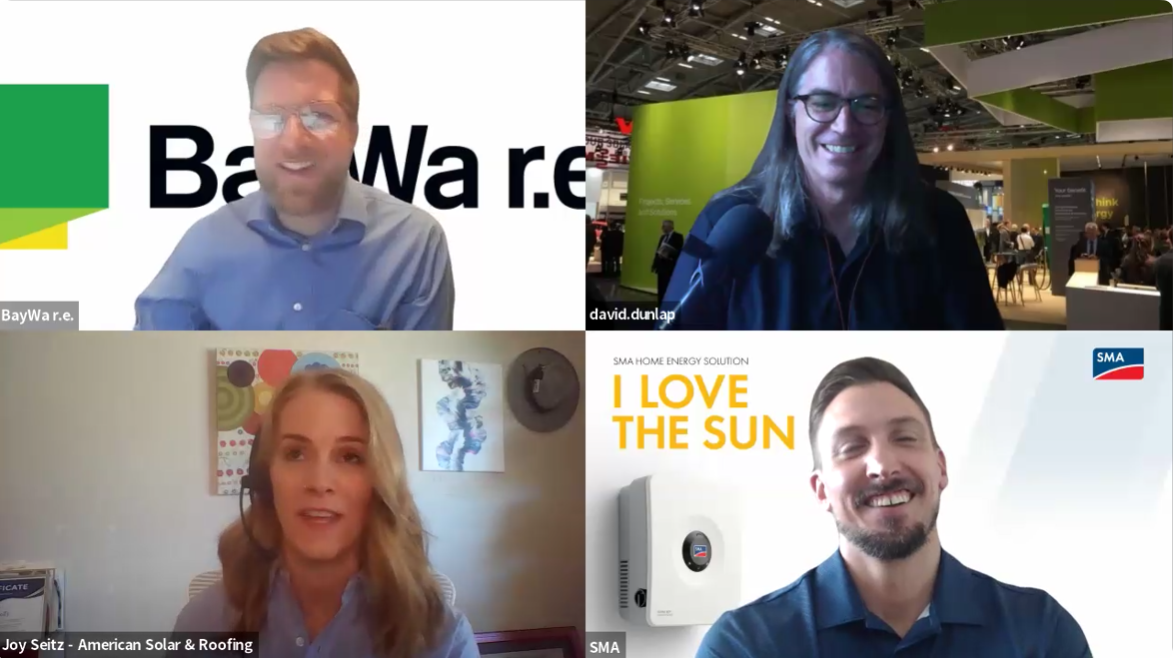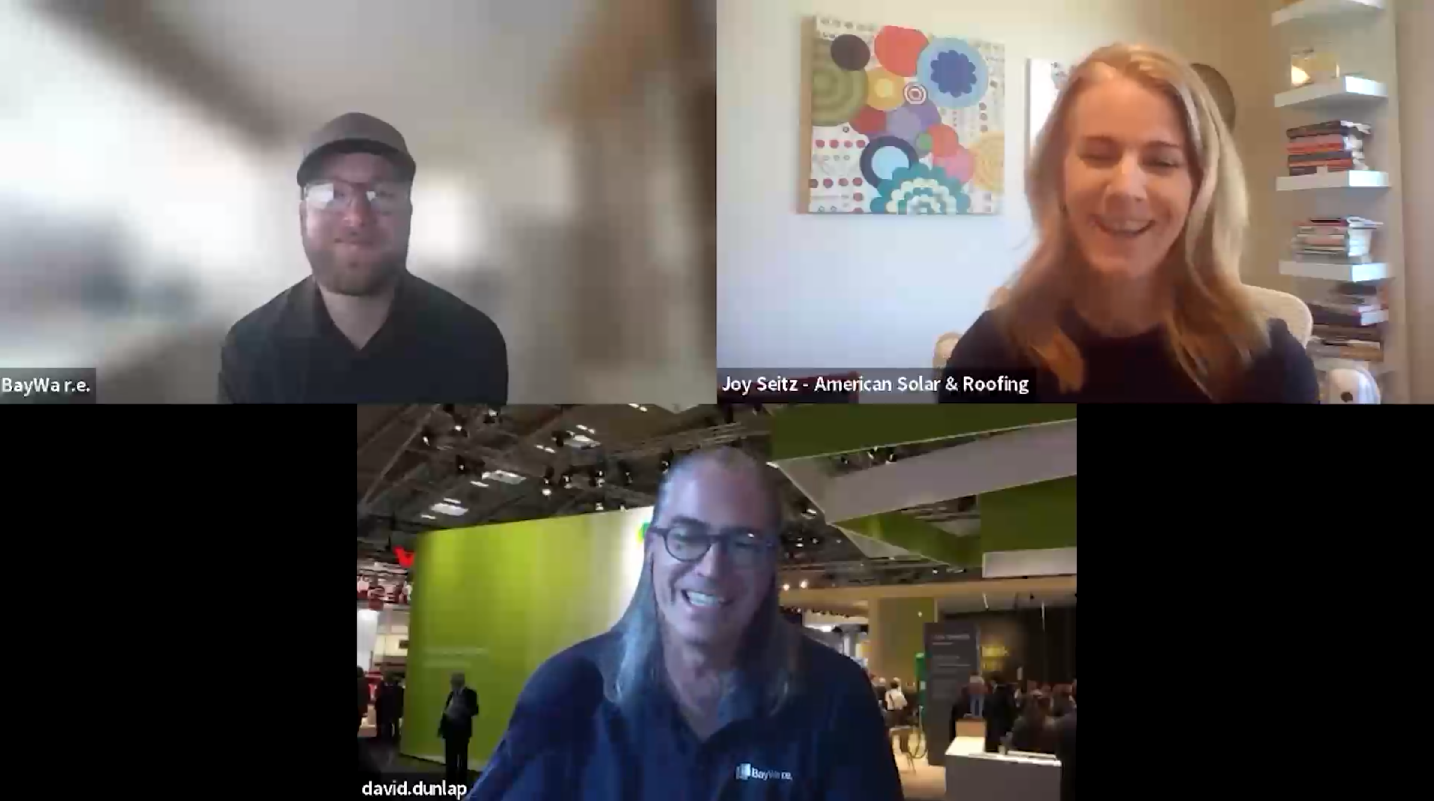Launched during the start of the pandemic, our BayWa r.e. Solar Town Halls continues to bring U.S. solar contractors and industry leaders together to discuss the rising challenges and opportunities in the business of solar installation and deployment.
As we know, what gets decided in California state policy has broad implications for other states around the country. And now, California is a battleground for the future of solar, with the major utilities in the Golden State fighting against solar on multiple fronts. Whatever your state and local jurisdiction, your ability to succeed as a residential solar and storage contractor might be shaped by policy conversations happening hundreds of miles away in Sacramento and San Francisco.
With anti-solar bills such as AB 1139, and with licensing debates like the C-10/C-46 requirements being prime examples, solar businesses nationwide should track these California conversations. To explain why, our June 2021 Solar Town Hall gathered industry insiders to discuss policy and advocacy, utility rates, codes and standards, legislative momentum, battery and storage standards, licensing classification, and lots more.
New to BayWa r.e.?
Here are 10 reasons why more solar contractors are choosing BayWa r.e. Connect with our team today.
Barry Cinnamon, VCEO of Cinnamon Energy Systems in California
Ben Davis, Policy Associate with the California Solar and Storage Association (CALSSA)
Jeff Spies, President of Planet Plan Sets
Aaron Bingham and Kate Collardson, our Product Managers here at BayWa r.e. Solar Systems (USA) and co-hosts of our Solar Tech Talk podcasts.
WHY CALIFORNIA?
California has 12% of the U.S. population — but it also currently has 40% of customer-sided solar in the country, said Ben Davis, Policy Associate with the California Solar & Storage Association (CALSSA). But it’s the state’s history of air quality concerns and clean energy movements that allowed solar to take root — and flourish.
“The modern solar industry was born in California,” said Jeff Spies, President of Planet Plan Sets and a CALSSA Board Member as well as its Codes & Standards Chair. Spies says because California was such a hotbed for the early boom of off-grid solar and the subsequent grid-tied boom, the market momentum and demand for permits were able to drive the first policies and codes. “As a result, we got to develop the policies because of sheer volume — the number of installations going in residential, and now commercially. That really prompted the building department staff to question, ‘What should we look at, and what requirements should there be?’”
California is also a massive territory with a highly active and influential State Legislature and a complex, comprehensive system of regulatory agencies. Any interest group with enough financial and lobbying resources to reach these lawmakers and commissioners stand to influence real world policies.
WHY UTILITIES SEEK LEVERAGE
“California is one market in which those utilities can really test their ability to drive that conversation in a specific way and make sure that their perspective is the one that’s being represented in upcoming legislation,” said Aaron Bingham, co-host of our Solar Tech Talk podcast and a Product Manager at BayWa r.e. Solar Systems. “And that creates real challenges because if a policy is successful here, it has a very good chance of being successful in other states with other legislative bodies.”
So what agenda do utilities want to exert with their lobbying power? “If the utilities had their way, they would kill net metering and they would place fees on customer-sided solar,” said Ben Davis. “And so everyday it is a necessity for our industry to both fight for pro-solar policies and fight to stop anti-solar policies. Because if we didn’t do that, there would be no customer-sided solar — because the utilities and other stakeholders would purposely create a market environment in which solar wouldn’t be cost-effective.”
This extends to home storage. “I think the utilities fundamentally look at anybody else that generates electricity — even if it’s for their own use — as a competitor,” added Jeff Spies. “By and large… they look at solar plus storage as less future revenue. Every solar panel that goes up means less money that they and their infrastructure can make.” And with market forces and streamlined permitting decreasing the cost of equipment and installation, residential storage is poised to pose even greater threats to utility control. The SGIP program, for one, is administered by investor-owned utility Pacific Gas & Electric (PG&E) for the California Public Utilities Commission (CPUC) — potentially presenting conflicts of interest towards affordable storage adoption.
“So you’ve got the fox guarding the hen house, and the fox is just eating all the eggs to making it harder,” says Barry Cinnamon, CEO of Cinnamon Energy Systems and host of the popular Energy Show.
“If the utilities had their way, they would kill net metering and they would place fees on customer-sided solar. And so everyday it is a necessity for our industry to both fight for pro-solar policies and fight to stop anti-solar policies. Because if we didn’t do that, there would be no customer-sided solar — because the utilities and other stakeholders would purposely create a market environment in which solar wouldn’t be cost-effective.”
— Ben Davis, Policy Associate with the California Solar and Storage Association (CALSSA)
THE LICENSING BATTLE
Another surprising area where utilities can exert influence is contractor licensing. In California, there are two main licensing classifications that are allowed to install solar and storage: C-10, an electrician’s license, and C-46, a solar contractor license good for thermal, PV, and solar with storage. “What’s happened is that the utilities — via the International Brotherhood of Electrical Workers (IBEW) — are trying to prevent solar installers on the C-46 license from installing a battery, as either just any battery or as an added-on battery,” explained Barry Cinnamon. Solar contractors would then be limited to installing batteries only as part of a solar-plus-storage system.
The implication is that if a homeowner wanted to upgrade their system to add storage, the solar contractor would have to hire and work one-on-one with certified electricians and apprentices — whose certification requirements are within the purview of the IBEW. This adds costs and creates logistical jams, since electricians are already in high demand serving all other types of work.
“What ends up happening is that it’s very hard for solar installers who have a C-46 license — who’ve maybe been doing solar for 38 years — to actually add a battery,” said Cinnamon. “And you might ask why does the IBW care? Well, it’s back to the utility issue. The IBEW does most of the work for utilities… they get paid by the utilities, and so IBEW workers want to have more utility-scale batteries and solar installed. They basically want to stop solar customers from adding batteries from ordinary solar contractors.”
“What ends up happening is that it’s very hard for solar installers who have a C-46 license — who’ve maybe been doing solar for 38 years — to actually add a battery.”
— Barry Cinnamon, VCEO of Cinnamon Energy Systems in California
THE NET METERING BATTLE
The most public, but confusing, solar policy fight in California of late may well be Assembly Bill 1139 (AB 1139). “AB 1139 would have been the end of customer-sided solar in California,” said Ben Davis of CALSSA. “It was probably the single greatest threat the industry has faced in years.”
Davis explained that if passed, AB 1139 would have reduced the export rate to 3 or 4 cents a kilowatt hour, and also have tacked on a $70 to $90 per month charge for residential systems, and more for commercial systems. “That would have made the payback period on a solar system 50 years — which as folks know, that’s a little longer than the lifetime of a system,” said Davis.
“So it was incredibly gratifying to see AB 1139 defeated,” said BayWa r.e.’s Aaron Bingham. “- At the same time, while this was not my first time seeing this kind of legislation, it was one of the most sophisticated legislative attacks on solar PV that I’ve seen.”
More attempts may yet to come, as is the nature of a dynamic legislative policy arena like California, where lobbyists and activist groups from all sectors engage in battles over influence and messaging year after year. One player that stood out in this year’s AB 1139 fight was a third-party consulting group that was brought in to analyze the impact of California’s Net Energy Metering policy, and look at how solar should be valued going forward as a part of the electrical infrastructure within California. “And their analysis was incredibly biased: the points that they were making were kind of twisted truths,” noted Aaron Bingham, with the utilities basically painting a message to PV customers suggesting that their systems were subsidized by lower-income Californians, and creating further inequalities in society.
Which of course, is the exact opposite of our solar and storage industry’s genuine mission and intention — democratizing energy generation and access and making communities more resilient from utility failures and market forces.
WHAT YOU CAN DO — EVEN IF YOU DON’T LIVE AND WORK IN CALIFORNIA
You don’t have to live in California to track and pay attention to it’s battles. Kate Collardson, co-host of our Solar Tech Talk podcast and a Product Manager at BayWa r.e. Solar Systems, for example, is based in Colorado. “ I felt AB 1139 was a very important fight to track and to participate in to the extent that I could,” said Collardson, explaining how she took time to rally social media posts, and called California colleagues and friends to inform them on the true nature of the bill, asking them to call their legislator to not vote for its passage. “Because if it happened in California, then Colorado might be next.”
CALSSA’s Ben Davis agreed, saying that California AB 1139 was defeated because our solar industry and other passionate constituents spoke up, presenting real facts and exerting political pressure. “Legislators came to understand how AB 1139 would impact schools, low-income customers, hurt the environment, and would hurt resiliency,” said Davis. “Legislators also received hundreds, if not thousands, of phone calls into their offices from their constituents. So when we actually sat down to talk to them about 1139, they’d say, “What’s going on? This came out of nowhere, and I’ve received 1,500 calls in the past week.”
“Banding together and doing things like calling your assembly member, calling your state senator, letting them know your opinions — that absolutely works,” said Jeff Spies, who is based in California. “I know it might sound cliche, but it absolutely works.”
“Banding together and doing things like calling your assembly member, calling your state senator, letting them know your opinions — that absolutely works.”
— Jeff Spies, President of Planet Plan Sets
WHY GET ENGAGED IN POLICYMAKING AND CODE SETTING?
Getting engaged in your state’s policymaking and code-setting process can pay dividends for your solar business. “Being engaged, you can understand what’s coming down the pike,” said Cinnamon. “By being a member of CALSSA or SEIA and participating, you know what the fights are, and you kind of have a heads up on what’s going to happen.”
Cinnamon says tracking these policy battles through industry associations shed light on the growing market for batteries, for example. “I was able to prepare my business for that and be more well positioned to take advantage of the future,” said Cinnamon. “It really helps business owners. And I strongly encourage everybody to not only join, but also invest money and participate in your state solar association.”
BayWa r.e.’s own Kate Collardson reminded our contractor community not to overlook the code-setting side of policy conversations. “Codes and standards dictate what we install, where we install it, how we install it,” emphasized Collardson. “If we don’t have a voice in the creation of these codes and standards, we’re not going to like what they end up being.”
This also extends to how manufacturers react to shifts codes and standards. “We’ve seen equipment created because of codes over the past 10 years,” Collardson noted. “A change in a code cycle creates a huge shift in our industry on all kinds of levels. So, I think it’s very important for us to be involved in the process, to make our voices heard, to make sure that we’re onboard with the changes that come at us.”
YOU DON’T HAVE TO DO IT ALONE — PARTNER UP
If all this sounds daunting — worrying about policy and code battles several states away while trying to pay the bills and run your solar business — contractors should take comfort. This is why solar trade associations exist, pooling resources and time to track these policy conversations, and rally our professional community in unison. “Doing it through a trade organization like CALSSA is so much more effective than trying to do it independently,” said Jeff Spies.
Then there are customer-side advocacy organizations as well, like the Solar Rights Alliance in California, representing residential and commercial users. “We have something similar in Colorado called CitiSuns,” Kate Collardson mentioned.
In these organizations, the idea is that when someone gets solar installed on their home, the contractor then invites them to sign up to join that solar rights alliance. These alliances and organizations then educate solar homeowners when, who, and what they’re fighting for at their state’s legislative level. So that in addition to the unified voices of solar professionals, we can also rally the energy and support of solar users as well — jumping into action in solidarity.
“If we don’t have the support of the masses,” said Jeff Spies. “The likelihood that we’ll be able to battle back against these well-funded, intelligent people that want to kill solar and storage? We won’t win that fight.”
Thank you all again for participating in our Solar Town Hall events and being part of our #SolarFam! RSVP and tell a colleague — we’ll see you online June 24 for this important discussion.
Missed one of our events? Access all of our expert roundtables in our Solar Town Hall archives, find video excerpts on YouTube, and take podcast versions with you on the go via Spotify, Apple, or Google.
BayWa r.e. Solar Systems LLC supplies residential and commercial solar installers in the United States with quality solar + storage components, forecasting, business planning advice, and a community of experts. Visit www.solar-distribution.com to read our industry insights articles and stream our Solar Tech Talk and Solar Town Hall podcasts on YouTube and Spotify. Follow us on LinkedIn, Twitter, and Facebook to stay connected. Ask us about our Split Pay financing program and use our industry-leading Webstore to save time, get gear shipped, and get jobs done! Part of the BayWa r.e. Global family of renewable energy companies.
Subscribe to our newsletter
Stay up to date on the latest industry news, new product releases, BayWa r.e. news and more when you subscribe to our monthly newsletter.




